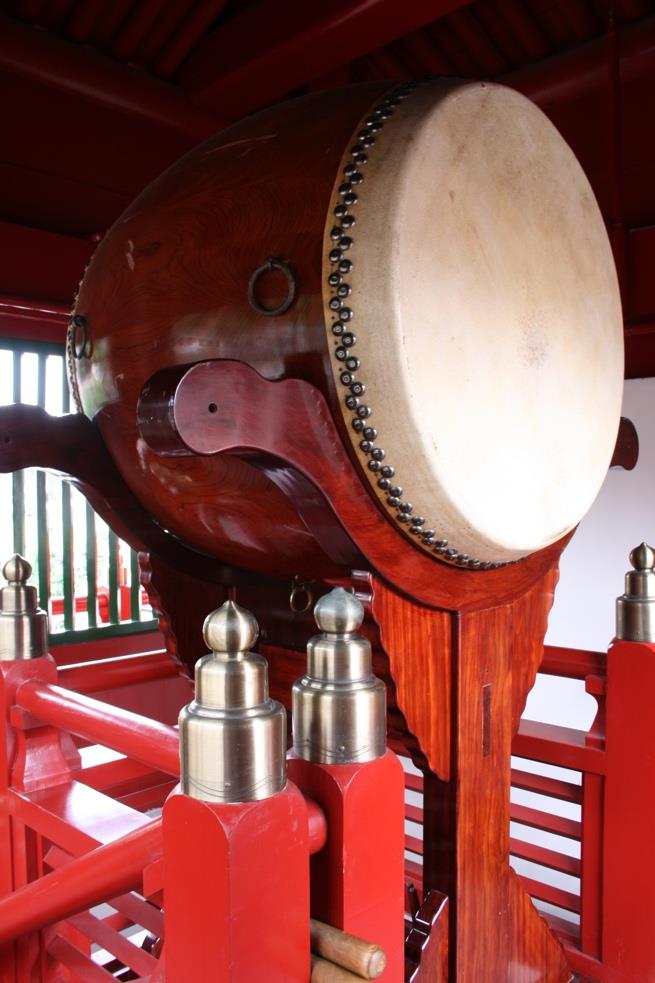First Storey
Front Courtyard Topics
First Storey Topics
Drum Tower
Location Description

The Temple Drum is placed inside the second storey of the Drum Tower, on the left side of the Mountain Gate.
About Temple Drum in Buddha Tooth Relic Temple & Museum

A metre deep and wide, the temple drum's well-polished maroon body is a hollow rosewood vessel with cowhide or drumskins stretched over its two circular open ends. The drumskins are fastened to the edge of the shell via two rows of closely spaced alternating metal studs. Six rings are mounted on its body with two each on the top and left side and one each at the bottom and right side (as seen when you are facing the drumhead used for drumming). These rings can be used for suspending the drum from an elevated height and to ease transportation and installation.
Also known as a double-headed barrel drum, it is supported by a wooden stand similarly polished and lacquered to reveal rich dark brownish red veins. The drum stand is a minimally decorated two-piece structure with its top 'U'-shaped ends supporting the two drumheads while the base of its legs—in an inverted 'Y' shape–—are joined at the base forming a square. To strengthen this support, the two legs are also joined in the middle. Attached to the back of its front leg near the base is a cylindrical container holding two drum sticks.

A smaller replica (above) of the temple drum can be found in our main prayer hall.
About Drum Tower and Drum
The term Drum tower (Chinese: 鼓楼; pinyin: Gulou; Japanese: korō or kurō [鼓楼]) is used to refer to a tower in the centre of an old Chinese city, housing signal drums. The drum tower is often located in the centre of a city, symbolising its central position. Hence the downtown districts of several Chinese cities have been named after the drum tower.
Drum towers can be found in a number of Buddhist temples in China and other countries of Chinese cultural influence as well.
In Japan, the drum tower housing a drum marks the passing of time. It used to face the bell tower (shōrō) and was situated next to the lecture hall (kō-dō), but now the drum is usually kept inside the main hall (rōmon).
Bells and drums were musical instruments in ancient China. Later they were used by government and common people as timepieces. The Bell and Drum towers were the centre of Chinese chronology during the Yuan, Ming and Qing dynasties.
The drum is a member of the percussion group of musical instruments, which is technically classified as the membranophones. Drums consist of at least one membrane, called a drumhead or drum skin, that is stretched over a shell and struck, either directly with the player's hands, or with a drum stick, to produce sound. There is usually a "resonance head" on the underside of the drum, these are usually tuned to a slightly lower pitch than the top drumhead. Other techniques have been used to cause drums to make sound, such as the thumb roll. Drums are the world's oldest and most ubiquitous musical instruments, and the basic design has remained virtually unchanged for thousands of years.

Venerable Chao Khun Fa Zhao visited numerous drum factories in China and Taiwan to evaluate the sound and quality of the drums produced.
Finally, the drum selected was specially handcrafted by Chuan Lung Art Co Ltd in Taiwan. The Company used traditional materials and techniques to produce this large one metre drum from a single piece of rosewood. Its deep and loud resounding booms complement well with the Temple Bell.
Consecration Ceremony

The Drum was consecrated in a special blessing ceremony on 28 April 2007.
Temple Daily Opening and Closing Ceremony


Drum ritual takes place at drum tower during the morning opening ceremony and evening closing ceremony.
Bibliography:
- Japanese Architecture and Gardens, Hirotaro Ota, Kokusai Bunka Shinkokai, 1966, page 90